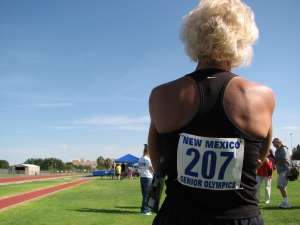I was introduced to the term geezer jock in 2004 while working for USA Volleyball when a magazine by the same name made a pitch at one of the bi-annual meetings of the Regional Operations Division – the division in charge of growing and organizing age-bracketed play at local and national levels. It was at this time that I was also introduced to the Huntsman Games, the World Senior Games for ages 50 and older held annually in St. George, Utah. Since volleyball is one of 24 sports offered in St. George, the masters and senior divisions at USA Volleyball’s Adult Open Championship often serve as a venue for practice or recruiting for the World Games later in the year. This summer, I attended the New Mexico Senior Olympics where I had the opportunity to volunteer for the race walk competitions and watch several swimming events. My attendance at the New Mexico games, renewed my interest in the issue of GeezerJock magazine I had tucked away 4 years ago and piqued my curiosity about the role of the aging athlete in US physical culture. This, coupled with the obsessive focus on age demonstrated by Olympic media coverage of Dara Torres, 41 – discussed in the previous post – begs the question, who, and what, are geezer jocks?
The discussion surrounding GeezerJock magazine’s name change last year – now Masters Athlete – captures some of the duality and concerns of the term. As one reader suggested, “GeezerJock is a mixed term: “geezer” pejorative, “jock” complimentary…Masters Athlete is much better”. However, most readers lamented the change, blasting the ownership’s decision as a “vanilla shade of political correctness” and mourning the humor and novelty they were so proud of in the former title. Much of fondness for geezer jock stemmed from the contradictions inherent in the label, the abilities of an aging and previously regarded disabling body, that were simultaneously addressed and rebuffed through its use by self-selecting active seniors and the magazine’s former name. Although GeezerJock, came under fire for being exclusionary to a younger magazine demographic and serious older athletes, especially women, as well as generally derogatory and demeaning, Masters Athlete, has not been without controversy and has been criticized for its elitism.
Masters Athlete assists in battling the negative connotations of a ‘geezer jock’ and broadens the target demographic of mature active adults. Masters Athlete claims to cater to an active population of adults 30 and older (that’s right, I’m a geezer). Masters competitions often set a minimum age of 35 for entry – except Masters swimming which starts at 18. However, many organized senior competitions and events classify the would-be geezer jock slightly older. The masters and senior divisions at USA Volleyball’s Adult Open Championships begin at 40 & over and move up in 5-year increments to 70 & above for women and 75 & above for men. The Huntsman Games lowered their minimum age from 55 to 50 in their second year to encourage earlier participation and have a similar 5-year bracketing system. The New Mexico Senior Olympics is also 50 years and older, as are the local and national Senior Olympics which are part of the same qualifying system. Here too, participants compete against only people in the same 5-year age bracket. So a defining characteristic of masters and senior competitions is the implementation of competitions based on age groups, usually in 5-year increments, rather than only a specific age minimum. ‘Maximum’ age is often determined by the waning of registration for the uppermost age-bracket events, often differing for men and women. In this regard, mature athletes can be classified as age-group competitors; athletes competing in age-adjusted groups based on medical rationale for the speed of deteriorating health with the goal of creating a more fair and level playing field.
In a 2007 Washington Post article, columnist Joel Achenbach outlines the rise of the alpha or frisky geezer, the disfavor of the word senior, and the decline in rates of disability in the 65 and older population. Using now familiar rhetoric describing the increase in longevity and active lifestyles of Baby Boomers, Margaret Guroff, health editor of the AARP magazine contributes to the article, “We get so many pitches about people over 60 riding their bikes across the country, or running in 100-mile marathons, we have to tell them, ‘Great, but this is not really news anymore,’ “. Alpha, frisky, or jock geezer, mature, masters or senior, or my preference, age-bracket competitors or just plain athletes, the burgeoning demographic of active 30+-year-olds offers a site ripe for the production and institution of health, fitness, (dis)ability, and ethical sporting discourse. As a large and affluent corner of the consumer market, the active aging population is an important part of a carefully constructed empire built on the benefits of movement for the aging body which has developed around structured events, competitions, and leisure-based consumption. As research across kinesiology delves into the literal micro-levels of the aging body, the larger societal implications of and for a growing aging population should be considered as well, as a target demographic in physical cultural studies research.


Great summary, Jennifer! I’m thrilled that you discovered Masters Athlete (formerly GeezerJock), which I’ve contributed to since the beginning.
Among the many things I love about masters sports is the amazing personalities and life stories of its participants. High school athletes can be boring. Masters never are.
Yep, I loved GeezerJock magazine until the name change. People who take themselves too seriously are crashing bores. Have not read it since.